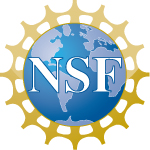NRAO Newsletter
Volume Vol#, Issue Iss#
Day# Month# Year#
NRAO Newsletter
Volume Vol#, Issue Iss# • Day# Month# Year#
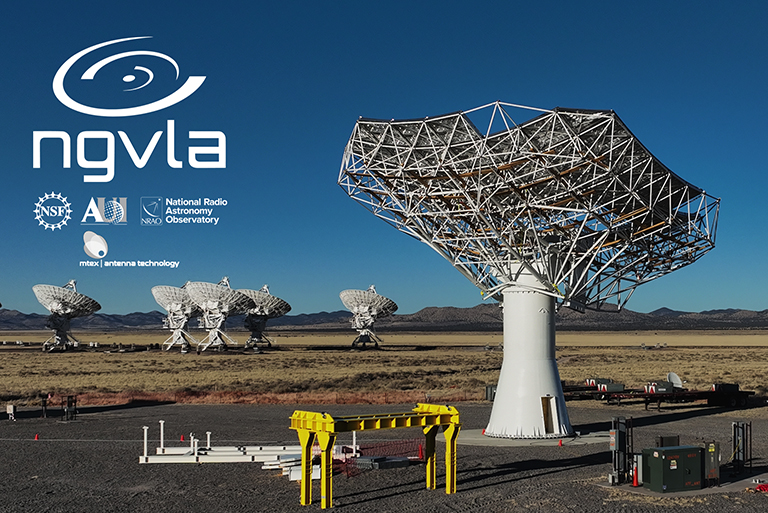 The Next Generation Very Large Array (ngVLA) prototype antenna dish was lifted onto its pedestal on February 6, 2025. Watch the timelapse of the dish lift event!
The Next Generation Very Large Array (ngVLA) prototype antenna dish was lifted onto its pedestal on February 6, 2025. Watch the timelapse of the dish lift event!
Upcoming Events

ALMA Data Reduction Party: Polarization
March 3-6, 2025 | Charlottesville, Virginia

Contents of the Fermi Bubbles at Green Bank Observatory
May 4-7, 2025 | Green Bank, WV

Cosmic Horizons: AI-Powered Insights
May 6-8, 2025 | Austin, Texas

North America-Taiwan joint ALMA Science Workshop
June 16-20, 2025 | Taipei, Taiwan
ngVLA Milestone - Prototype Dish Lift

U.S. NSF / AUI / NSF NRAO
A new milestone in the ngVLA Project was reached as the prototype antenna dish was lifted onto its pedestal on February 6, 2025. Viewers worldwide watched as the 18 meter dish moved into position. The astronomical and engineering community have contributed to the success of this milestone in driving the science, design, and construction of this prototype scientific instrument - a path to opening a new window on the Universe.
Read about the ngVLA Project and how to be involved in the community and science drivers.
Click here to watch a replay of the live stream!
Science Spotlight: Tracing massive galaxy assembly with ALMA + JWST
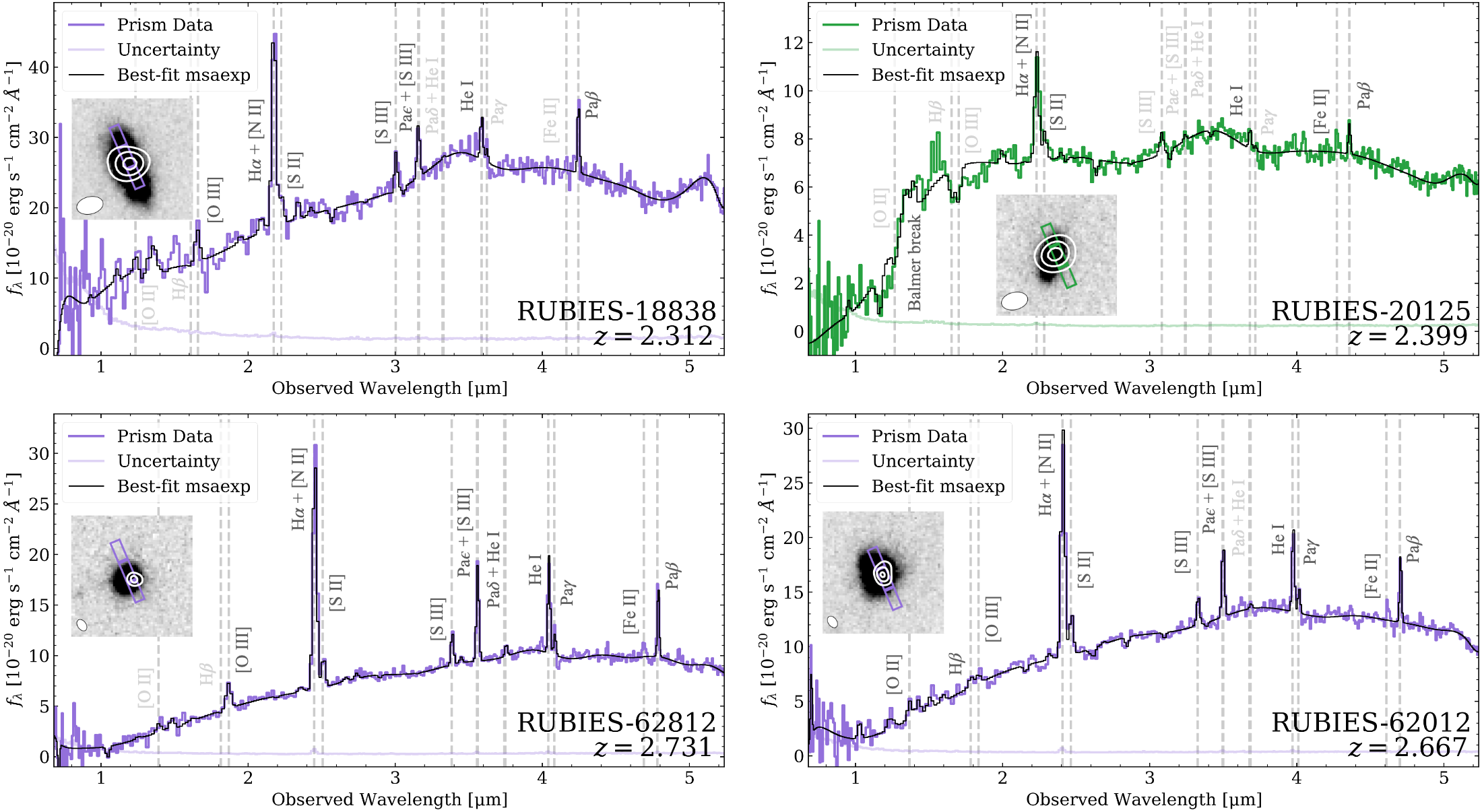
Figure: JWST/NIRSpec PRISM spectra for the sample of dust-obscured galaxies, with starbursts in purple and the post-starburst source in green. The JWST/NIRCam image for each source is shown as an inset, with the position of the NIRSpec slit overplotted on each image in purple or green, and the ALMA contours shown in white.
Throughout the first half of the Universe, star formation in early galaxies drives two key cosmic transitions. In the first billion years, the Epoch of Reionization marks the final phase change as some of the first galaxies ionized the neutral Hydrogen gas around them. Following this epoch, ongoing star formation propels the Universe from an interstellar-medium-dominated era of gas accretion to a stellar-mass-dominated era of gas depletion. In between, galaxies and large-scale structures are evolving dramatically, and in some cases, more rapidly than expected.
In my research, I chart this rapid evolution by tracing the fuel, product, and byproducts of star formation in massive galaxies in order to understand the boundary conditions of cosmic assembly. Observing these multiple components requires multi-wavelength efforts; at rest-frame ultraviolet-optical to trace ionized gas and stellar emission (e.g. Cooper et al. 2024), at rest-frame far-infrared to trace molecular gas and dust (e.g. Cooper et al. 2022), and with spectroscopic detail to probe interstellar physics (e.g. Cooper et al. 2025a).
In my most recent work (Cooper et al. 2025a), we leverage joint ALMA and JWST/NIRSpec observations to trace the dust content and star formation histories of the galaxies responsible for forming most of the stars in the Universe: dusty star-forming galaxies. While photometrically, each galaxy in our sample is a canonical dusty starburst, spectroscopy reveals that one source has a clear Balmer break (Figure 1). Combined with the ALMA constraints, this demonstrates that the galaxy has an evolved stellar population and recently transitioned to a post-starburst phase. Using detections of multiple Balmer and Paschen lines, we also investigate dust content by constructing the first detailed optical attenuation curve for such dust-obscured galaxies. We find the attenuation curve generally consistent with the local starburst model, but with a lower optical extinction ratio, potentially indicating smaller dust grains or differences in star-dust geometry.
To follow my recent and ongoing work using ALMA, JWST, and other world-class observatories to chart early massive galaxy evolution, check out my website here, and my recent publications here.
VLASS Quick Look Median Stacks
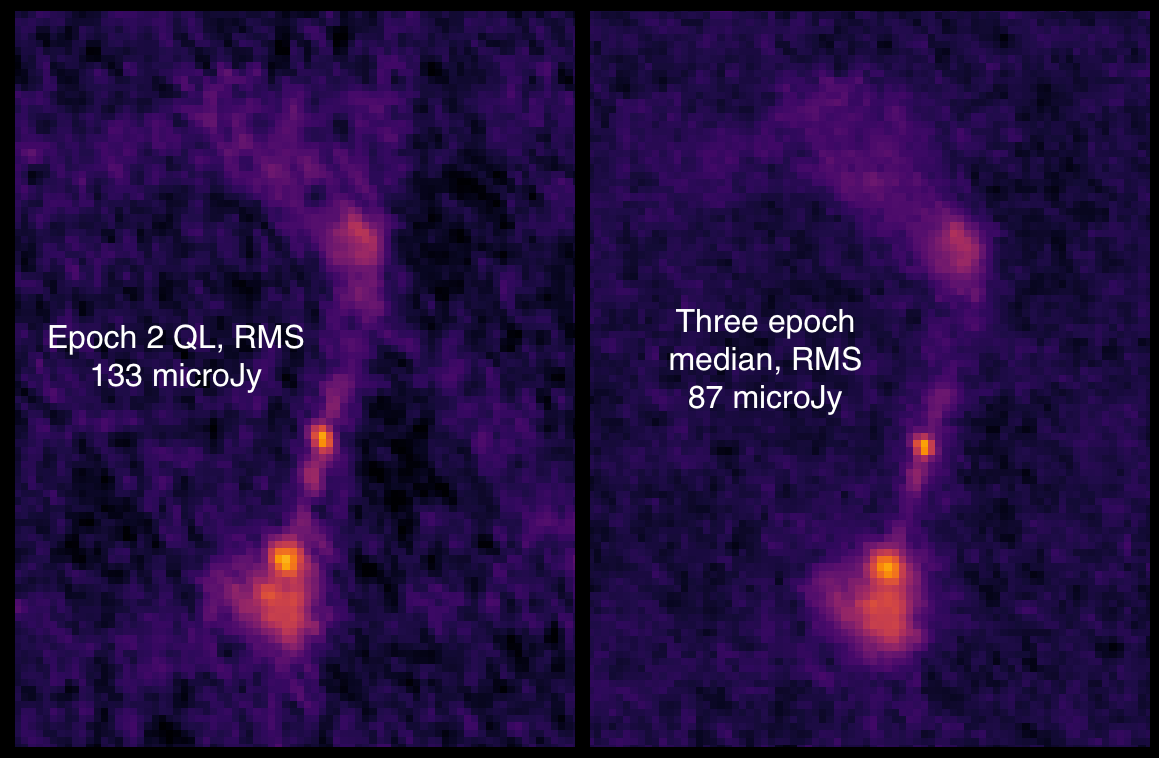
Two images of an FRI radio galaxy in VLASS: on the left the epoch 2 Quick Look image; on the right the median stack of all three VLASS epochs.
A new VLA Sky Survey (VLASS) Enhanced Data Product is now available from the VLASS archive cache area. Jansky Fellow Dillon Dong has made median stacks of the Quick Look images from the three VLASS epochs. These images are deeper than the individual per epoch Quick Look images and, being medians, also have fewer artifacts. They are thus ideal for studying faint sources and low surface brightness emission detected in VLASS. The stacking results in photometic and astrometric accuracies somewhat better than those of individual epoch VLASS Quick Look images (see VLASS Memo 13) due to the reduction in noise and systematics. The images are available on the VLASS archive website.
ALMA Ambassadors Cycle 12 Proposal Preparation Events
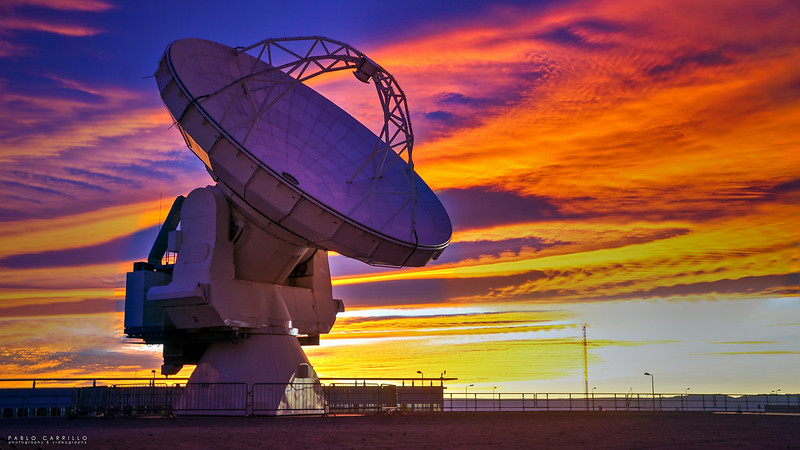
In advance of the Atacama Large Millimeter/submillimeter Array (ALMA) Cycle 12 Call for Proposals deadline, the North American ALMA Science Center (NAASC), along with current ALMA Ambassadors, have organized a series of ALMA proposal preparation workshops from March 21 - April 5, 2025. The goal of these events is to provide users with the knowledge they need to carry out cutting-edge scientific research using the ALMA facilities. We are particularly interested in reaching new users, so no experience with radio astronomy is required to participate!
These ALMA talks are hosted by experienced postdocs and graduate students as part of the ALMA Ambassadors program. Registration for these events is free. The workshops are designed to assist you in proposal preparation and observation planning for ALMA Cycle 12, and may include talks on the following topics:
- ALMA Basics and Cycle 12 Capabilities
- Radio Interferometry Basics
- Cycle 12 Proposal Preparation and the Proposal Review Process
- Introduction to the ALMA Observing Tool
- ALMA Data Products, Archive Use, and Notes on the Pipeline Weblog
- Common Astronomy Software Applications (CASA) Simulations
- Science-ready Data Products
- Imaging with CASA
Information on the locations and dates for these workshops is available on the NAASC Community Events webpage and in the table below.
| Dates | Workshop Location | Ambassador |
|---|---|---|
| March 21, 2025 | University of British Columbia | Anan Lu |
| March 21, 2025 | University of Texas, Austin | Olivia Cooper |
| March 25, 2025 | University of California, Berkeley | Nayana A. J. |
| March 25, 2025 | Johns Hopkins University | Pallavi Patil |
| March 26, 2025 | McGill University | Anan Lu |
| March 26, 2025 | Harvard & Smithsonian Center for Astrophysics | Jakob den Brok |
| March 28, 2025 | Universidad de Chile | Pietro Curone |
| March 31, 2025 | University of Washington | Gourav Khullar |
| April 4-5, 2025 | University of Missouri, Columbia | Teja Teppala |
| April 4-5, 2025 | University of Puerto Rico (Río Piedras) | Luis Henry Quiroga-Nuñez |
Later in the year, the ALMA Ambassadors will run another series of community events focused on the processing and analysis of ALMA data. Those events will be announced in a future NRAO Science Newsletter, so stay tuned.
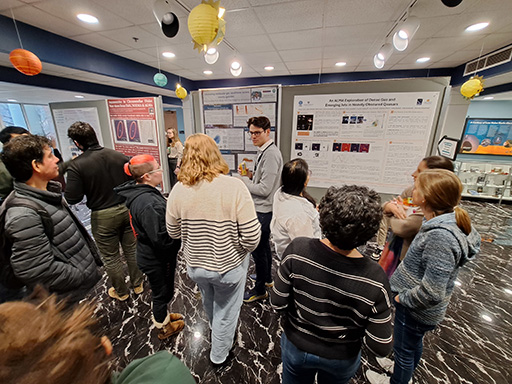
Interested in becoming an ALMA Ambassador? Applications for the Cycle 13 ALMA Ambassadors cohort will be due later this Spring. Details will be announced via this Science Newsletter. (Left: Ambassadors present their work at the NSF NRAO in Charlottesville, February 2025.)
ngVLA Project News

ngVLA Dish Lift Stream
Construction of the ngVLA prototype antenna was streamed live on February 6, 2025. Viewers worldwide watched as the 18 meter dish was successfully lifted onto its pedestal. Missed the live stream? Click here to watch a replay. (Timelapse courtesy of Daniel Faes)
ngVLA Antenna Design To Be Used in Germany
Our German colleagues will use the ngVLA antenna design to construct a cutting-edge antenna atop Germany’s highest mountain. Known as the Wetterstein Millimeter Telescope, this antenna could interface with the ngVLA, while also having the capability to function independently. The German project is funded by the Bavarian State Government and regional universities, as announced here.
Changes to the ngVLA SAC
We are pleased to welcome Anthony Gonzalez (University of Florida), Matthias Kadler (Wurzburg University) and Jean Turner (UCLA) to the ngVLA Science Advisory Council (SAC). Andrew Baker (Rutgers), Edwin (Ted) Bergin (University of Michigan), Laura Blecha (University of Florida), Geoff Bower (ASIAA), Maria Drout (University of Toronto), Megan Johnson (USNO) and Cherry Ng (SETI) have recently stepped down from the SAC, and we are grateful to them for their past service. Lists of current and past SAC members are posted here.
ngVLA Science - Time Delay Cosmography and H0
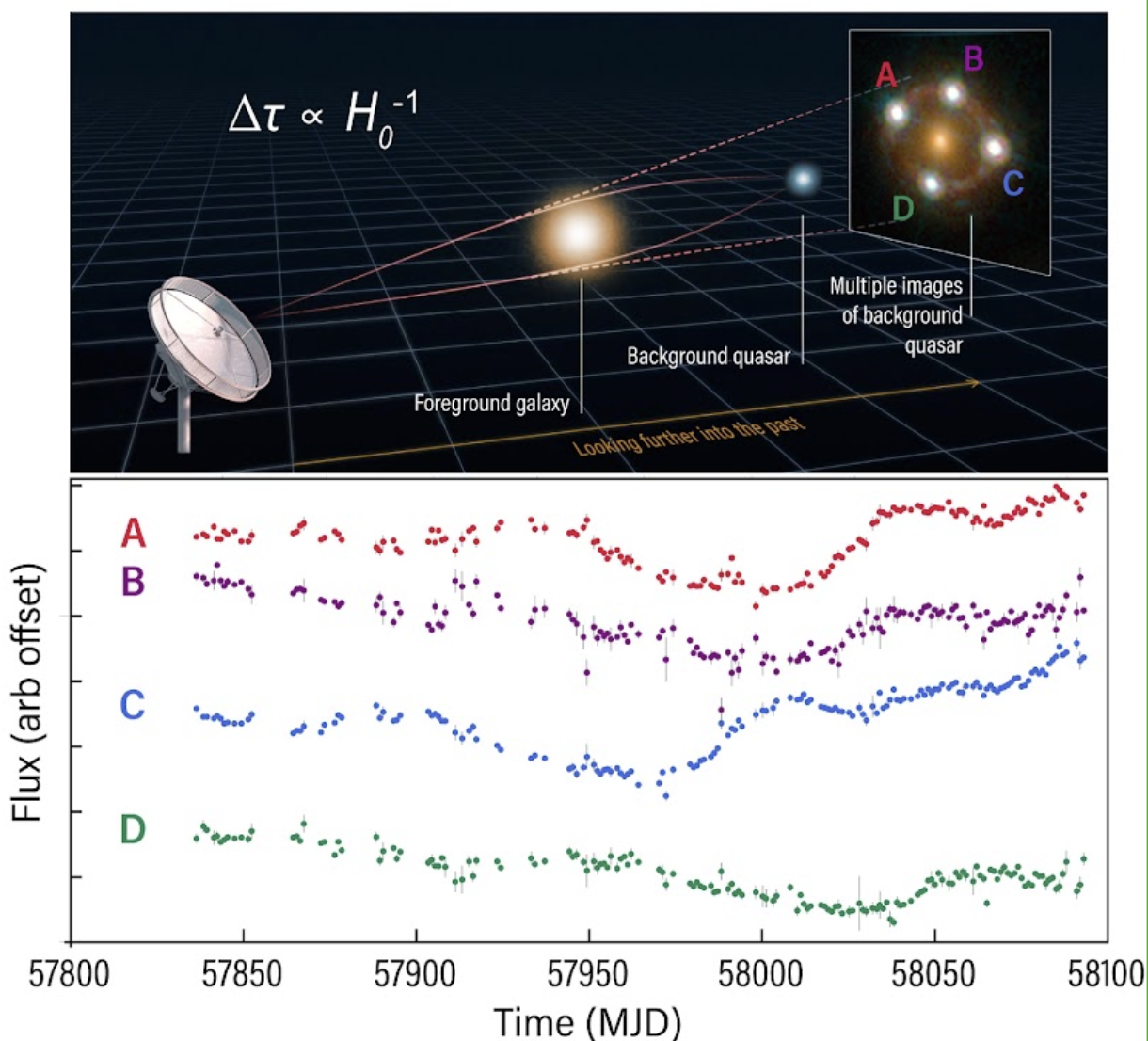
Figure: Schematic of how time delay cosmography works.
The number of strong gravitational lensing systems will surge thanks to up-coming infrared imaging surveys such as Euclid, Rubin and Roman. A dramatic increase in strong lenses will also occur at radio wavelengths, by mining the 109+ sources detected at 0.7-2 GHz with the 2000-antenna Deep Synoptic Array (DSA-2000) (Hallinan et al. 2019). In McCarty & Connor (2024), we predict that DSA-2000 will discover about 105 strong radio lenses. We forecast synergies with up-coming optical and infrared surveys, which will provide redshifts plus multiwavelength information. We also describe applications of the strong radio lenses, including time-delay cosmography for measuring the Hubble constant H0. Light from multiple images in a gravitational lens will reach the observer at different times (see figure). For steady sources, the difference in arrival times cannot be measured. But time-variable sources like blazars allow the time delay to be measured. The time delay is due to a difference in path lengths and gravitational time dilation near the deflector. The time delay thus encodes information about the geometry of the universe, and is inversely proportional to H0 (reviewed in Oguri 2019). Lenses with 4 or more images offer multiple constraints on the time delay. We expect about 100 quadruply-lensed blazars with >10% variability in the DSA-2000 sky. Dedicated monitoring of them with the ngVLA could constrain H0 to within 1%, a highly competitive level. With ngVLA subarraying, the monitoring could be customized to each lens' angular scale and not suffer from the months-long gaps currently caused by VLA re-configurations.
Since 2015 the acronym ngVLA has appeared in 1260+ publications indexed in the SAO/NASA Astrophysics Data System. This article continues a regular feature intended to showcase some of those publications. We are especially interested in showcasing work done by early-career researchers. The collection of showcase articles can be viewed online. Anyone wishing to volunteer to author a feature should contact Joan Wrobel.
ALMA Program News
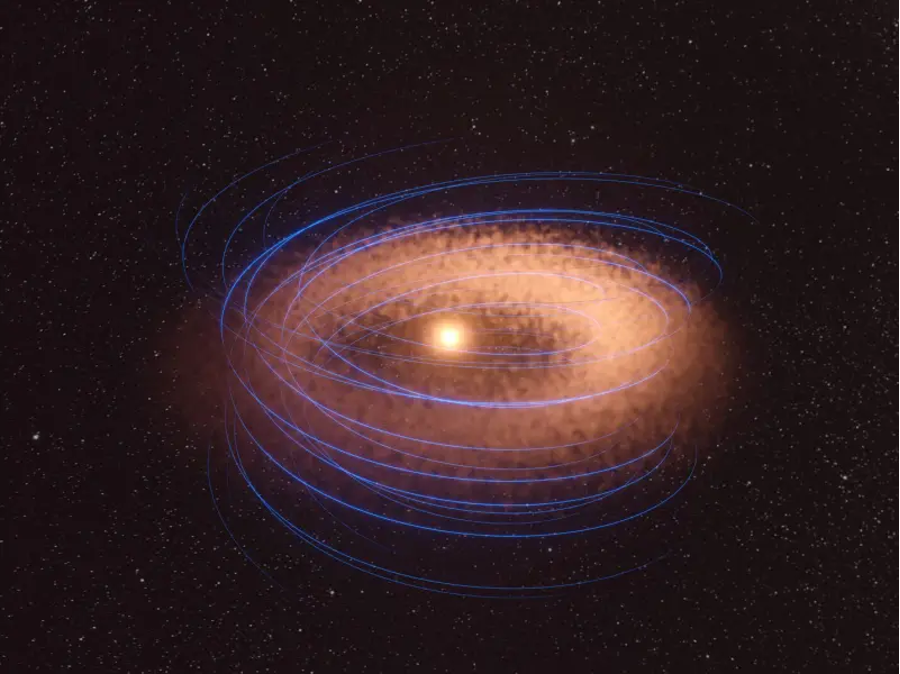
ALMA observes a magnetic field in a protoplanetary disk for the first time. Read the press release.
ALMA Status
The array is currently in configuration, C-4, with 780m maximum baselines nominally producing a 0.9" beam at 100GHz. The February engineering shutdown began on February 3rd at 09:00 am CLT. Owing to expected poor observing conditions during austral summer observations are suspended and an engineering period is undertaken. Observations have resumed in configuration C-4, until March 19th, after which ALMA transitions to configuration C-5, with a nominal 0.6" beam.
Announcement for early proposal planning for Cycle 12
An announcement of the schedule for proposal planning for Cycle 12 was made in December. To assist users with early proposal planning for ALMA Cycle 12, the following key dates (anticipated) have been announced:
- 20 March 2025: Release of the ALMA Cycle 12 Call for Proposals and Observing Tool, and opening of the archive for proposal submission
- 24 April 2025: Proposal submission deadline
- October 2025: Start of Cycle 12 observations, spanning 12 months
Other information on Cycle 12 is available on the ALMA portal. Full details will be published in the Cycle 12 Call for Proposals.
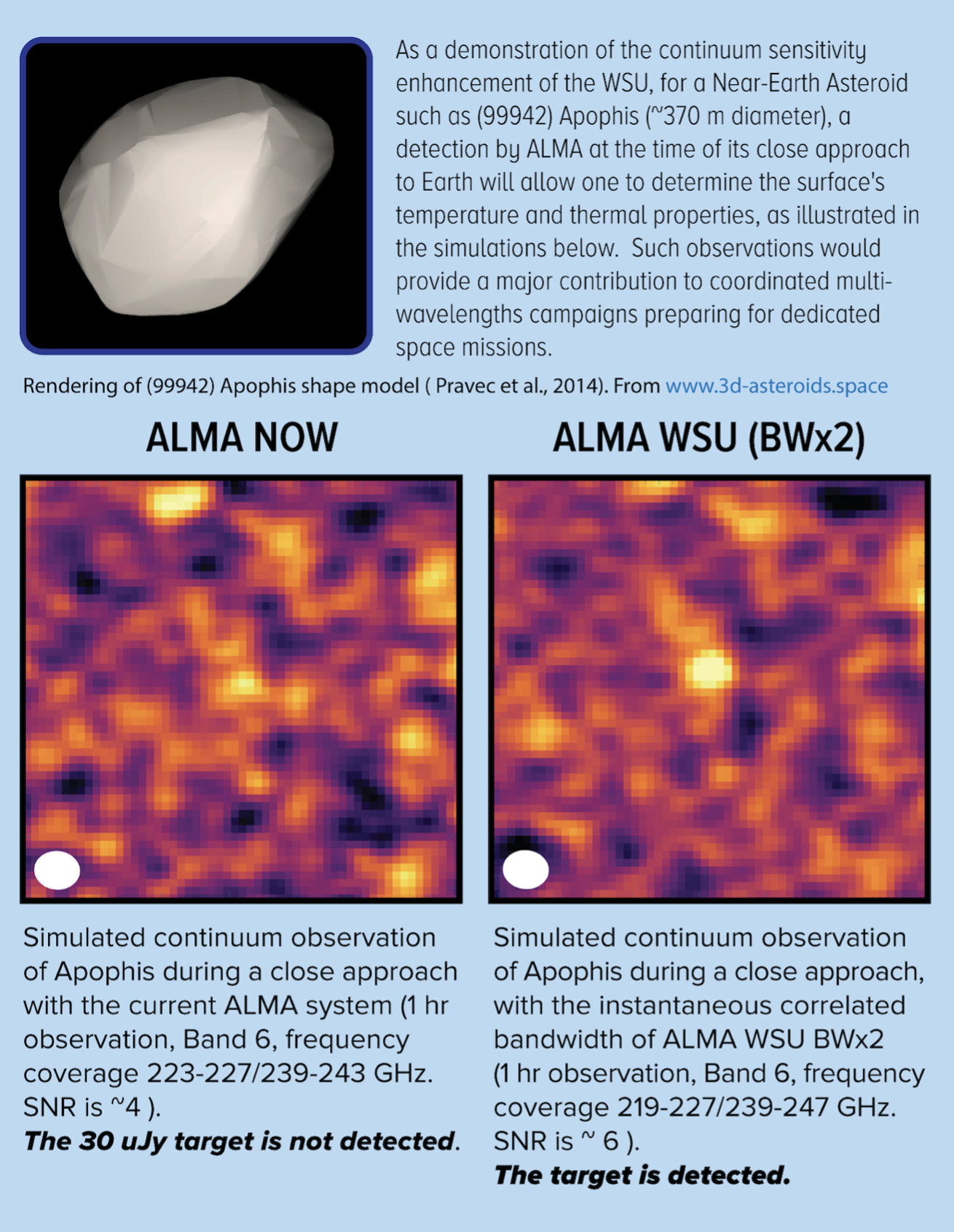
ALMA Wideband Sensitivity Upgrade (WSU)
Preparations are under way for the WSU System Preliminary Design Review which will be held at NRAO / Charlottesville on July 8-10, 2025. The scope of this major review includes, amongst other topics, plans and strategy for assembly , integration, verification and commissioning (AIVC), plans for the transition towards WSU operations, and definition of requirements, specifications and interfaces.
New Data that Challenge Underlying Assumptions in Early Galaxy Evolution
From the production of the first dust grains to the growth of the first supermassive black holes, paradigms describing galaxy evolution that were once thought fixed and universal are now being contested. Thanks to technological advances and synergies across infrared and millimeter facilities such as JWST and ALMA, the galaxy evolution community is forced to contend with a growing number of observations that require revised frameworks to explain observations in the first half of the Universe. Our goal is to re-conceptualize long held assumptions in light of new observations and theory. We emphasize that several topical areas of expertise across astronomy working in concert are critical for achieving this and we welcome applicants from diverse research areas.
As galaxy evolution sciences are revamped and revitalized, so too is the culture of astronomy through new ways of creating, collaborating, and sharing knowledge. Through this spirit, a portion of the workshop will be dedicated to sessions on topics driven by participant interest, such as inclusion, advocacy, justice, climate change, science communication, and more. Participants will be encouraged and empowered to lead sessions, hackathons, and/or discussions surrounding these topics.
This conference will be held at the Schoodic Institute, Acadia National Park, Maine from 28 July - 1 August, 2025. Applications are due by March 7th, 2025.
Science with strong lensing, ALMA and next generation radio interferometry
May 6-9, 2025 - NRAO Charlottesville
Thousands of strongly lensed galaxies have been discovered in the past 5-10 years using multi-wavelength approaches, offering magnified views into the hearts of active galaxies in the early Universe. This meeting will include a mix of discussions, talks and careful inspection of images and techniques to make the most out of ALMA observations of strongly lensed galaxies, as these objects offer the only means to access 10-100s pc scale at z>1.The workshop will be led by the Planck All-Sky Survey to Analyze Gravitationally-lensed Extreme Starbursts (PASSAGES) international collaboration, including experts who have closely examined strongly lensed systems using ALMA and other radio interferometers. We aim to enable a better understanding of how to systematically analyze the conditions of star formation at high redshift in the next generation of ALMA.
More info is on the PASSAGES Collaboration webpage.
Infrared Fine-Structure Lines Workshop
This 4-day conference will take place June 10 - 13, 2025 in the Science Laboratory Center at WSU in Winona, Minnesota, USA. The meeting will cover all topics related to the use of the infrared fine-structure lines as probes of the interstellar medium and properties of galaxies. Abstract submission is closed. Registration closes May 19, 2025. For more information please see the workshop announcement.
Third North America-Taiwan joint ALMA Science Workshop
The third North America-Taiwan joint ALMA Science Workshop, will occur June 16-20, 2025 at ASIAA. The registration is open now through Apr 8, 2025. This event will be an opportunity to present new ALMA scientific results in all scientific topics, with specific highlights on Band 1 and Wideband Sensitivity Upgrade (WSU) science opportunities.
International Symposium on Molecular Spectroscopy (ISMS)
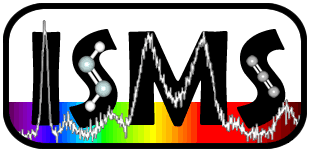
Abstract submission has been extended to March 8th, 2025. Reduced Registration (and dorms) deadline: March 15 - May 15; Full-Price Registration (and dorms) Begins: May 16
The ISMS is the leading annual conference in this dynamic and interdisciplinary field, bringing together experts for a unique blend of plenary talks from world-renowned leaders and parallel sessions featuring shorter presentations, many given by graduate students. The symposium fosters a highly collaborative and collegial environment, offering numerous opportunities for both formal and informal interactions. To encourage participation, registration and housing costs remain exceptionally low compared to similar conferences, making it possible for entire research groups to attend. In fact, many senior researchers in the field delivered their first-ever conference presentation at ISMS, benefiting from its welcoming and supportive audience.
Join us for the 78th ISMS, taking place June 23-27, 2025, in Urbana-Champaign, Illinois, and attend the ALMA/NGVLA-themed mini-symposium: "Astrochemistry - Laboratory, Computations, and Observations." Featured invited speakers include Roman Motiyenko (Université de Lille), Jenny Bergner (UC Berkeley), Jérôme Loreau (KU Leuven), Romane Le Gal (IRAP), Ilsa Cooke (University of British Columbia), Audrey Coutens (IRAP), and Xander Thelen (Caltech).
Webinar: Relativistic Field Theory for Microwave Engineers
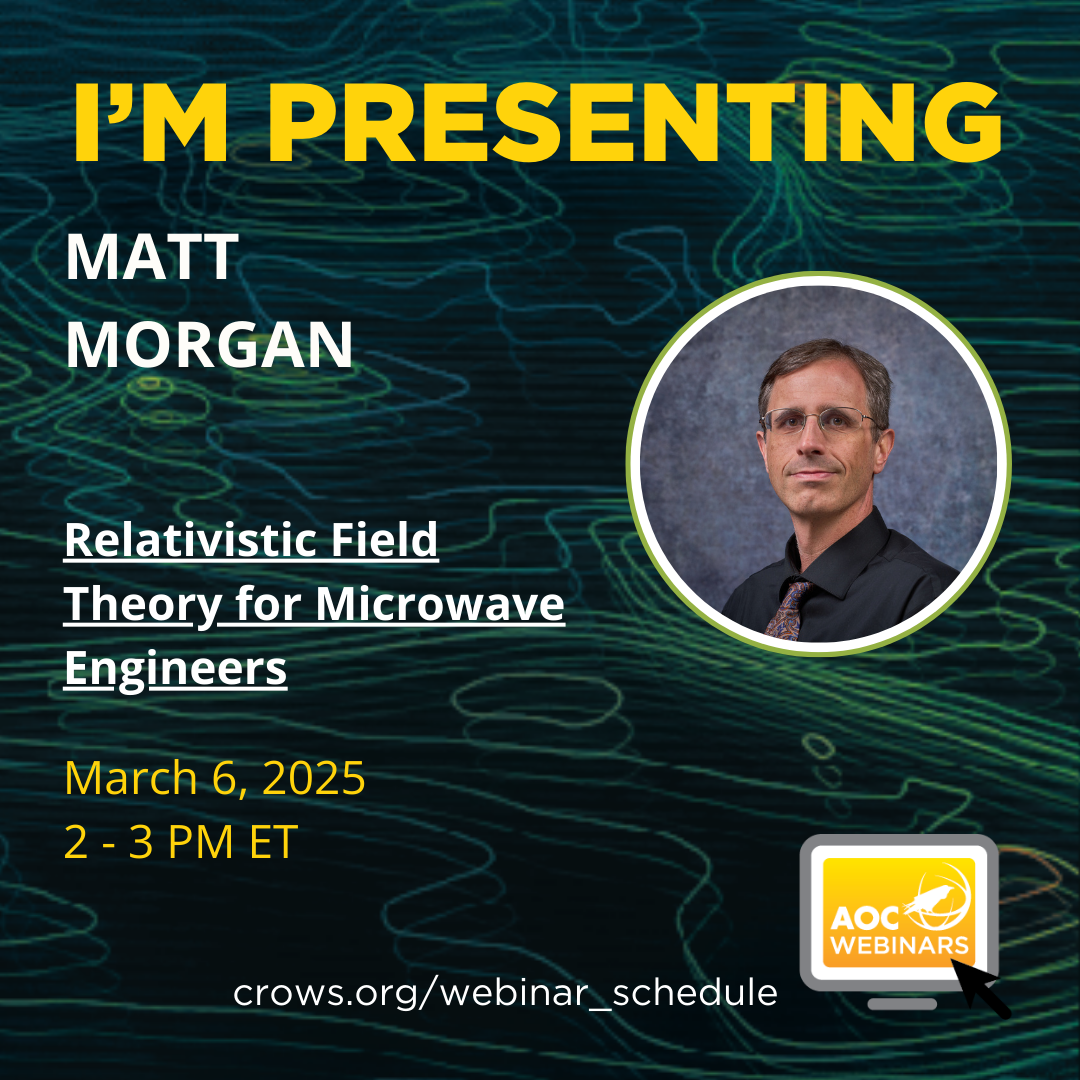
Matt Morgan (NRAO CDL) will be delivering an online webinar on March 6, 2025, about Relativistic Field Theory for Microwave Engineers.
Please register to attend this online talk.
Matthew A. Morgan is a Scientist with tenure at the Central Development Lab (CDL) of the National Radio Astronomy Observatory (NRAO). He has authored three books, over 60 papers, and 20 patents in the areas of monolithic microwave integrated circuit (MMIC) design, millimeter-wave system integration and packaging techniques, reflectionless filter development, high-speed serial communication, and ultrawideband millimeter-wave antennas. Dr. Morgan is currently the head of the CDL's Integrated Receiver Development program, and is involved in the design and development of low-noise receivers, components, and novel concepts for radio astronomy instrumentation in the centimeter-wave, millimeter-wave, and submillimeter-wave frequency ranges.
Contents of the Fermi Bubbles at Green Bank Observatory
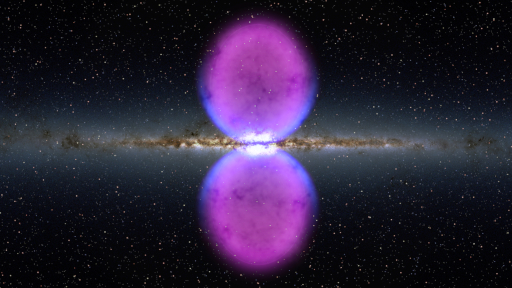
The Green Bank Observatory is hosting a special science meeting May 04-07, 2025 on the Fermi Bubbles in honor of Jay Lockman's retirement and 50+ years of service to NRAO/GBO. This workshop will bring together scientists with diverse interests for lively discussions of the latest observations, computational models, and theories associated with the Fermi Bubbles.
Please register on the meeting website by March 07, 2025, as lodging is limited.
Submillimeter Array Call for Standard Observing Proposals - 2025A Semester

We are happy to announce the latest Call for Standard Observing Proposals for observations with the Submillimeter Array (SMA) during the 2025A semester, with observing period 16 May 2025 - 15 Nov 2025.
The deadline for proposals for the 2025A semester is:
5 Mar 2025 8PM Cambridge (EST) = 6 Mar 2025 1AM GMT = 6 Mar 2025 9AM Taipei
We wish to highlight important upgrades to the data reduction path, which now includes automated pipeline processing, and the option for application of bandpass and time dependent gains. We also announce development toward an "on-the-fly" interferometric mapping mode using the SMA, for efficient mapping of large areas.
The full Call for Proposals, with details on time available and the proposal process is available now at the SMA Observer Center (SMAOC).
Details on the SMA capabilities and status can be found at http://sma1.sma.hawaii.edu/status.html; proposal creation and submission is also done through the SMAOC. We are happy to answer questions and provide assistance in proposal submission, simply email the SMA with any inquiries.
VLA Membership
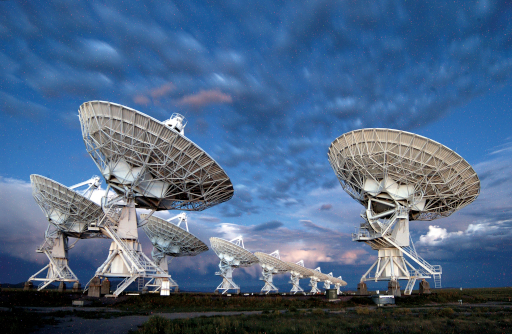
VLA Membership continues to grow! Members have made so much possible, from our new Mobile Planetarium to our VLA School Bus Fund - so we can share the awe-inspiring experience of visiting the VLA with more students. If you would like to support science and education programs with a VLA membership, sign up on the membership page.
Recent Science Media Releases
|
Next-Generation Very Large Array Antenna Design to be Used By German Astronomers
|
|
|
New Interim Director for the NSF Green Bank Observatory
|
|
|
A New Era of Data Compatibility in Astronomy
|
|
|
Contact the NRAO press office to share your new and exciting science results. |
From the Archives
Ellen Bouton

Each year the NRAO IT staff gather at one of our sites for a face-to-face SysAdmins meeting; the 2025 meeting will be held in March in Socorro. A photo of the 2003 meeting in Socorro shows (starting at the far end of the table and proceeding counter-clockwise) Gareth Hunt, Lothar Dahlmeyer, James Robnett, K. Scott Rowe, Tracy Halstead, Stephan Witz, George Martin, Allan Poindexter (barely in the picture), unknown, Kevin Long, Charlie Myers, Warren Richardson, Christian Saldias, Martin Pokorny, and Dave Brown, with Ruth Milner speaking. The photo was taken by Gene Runion, so it is probably his empty chair between Warren and Pat. Out of the frame in this photo, but also present at the meeting: Wolfgang Baudler, Marie Glendenning, Carolyn Hunsinger. Thanks to Pat Murphy, Derek Hart, and Gene Runion for help with IDs; can anyone provide the missing name on the back row?
From the Archives is an ongoing series illustrating NRAO and U.S. radio astronomy history via images selected from our collections of individuals' and institutional papers. If readers have images they believe would be of interest to the Archives, please contact Ellen Bouton.

